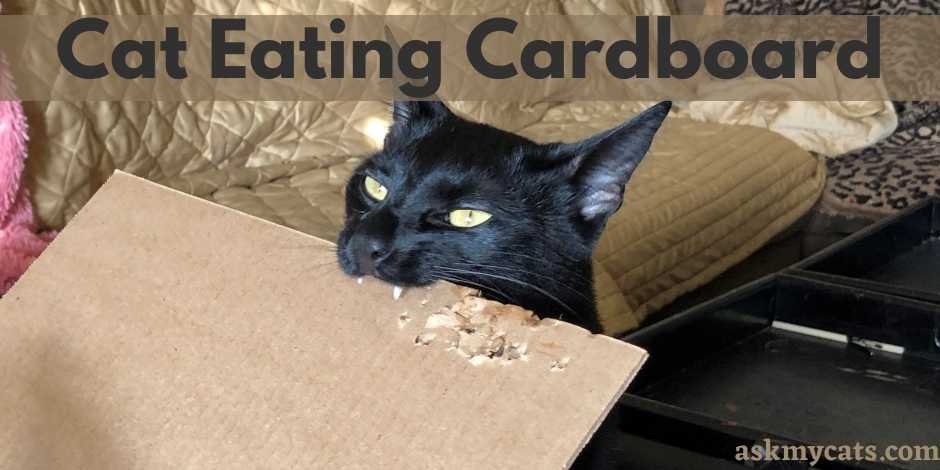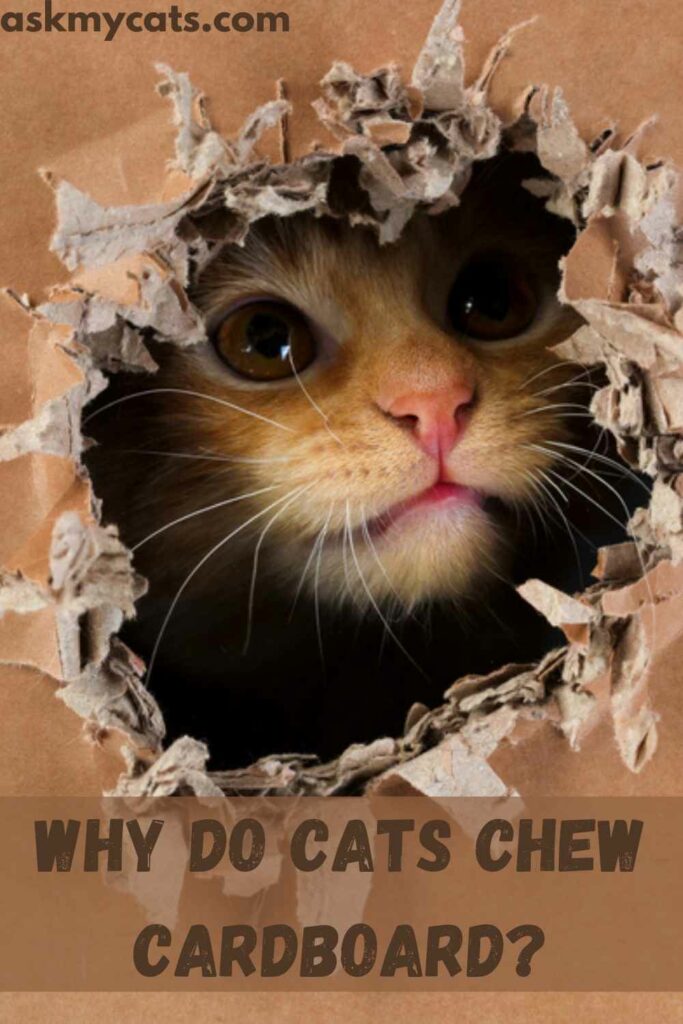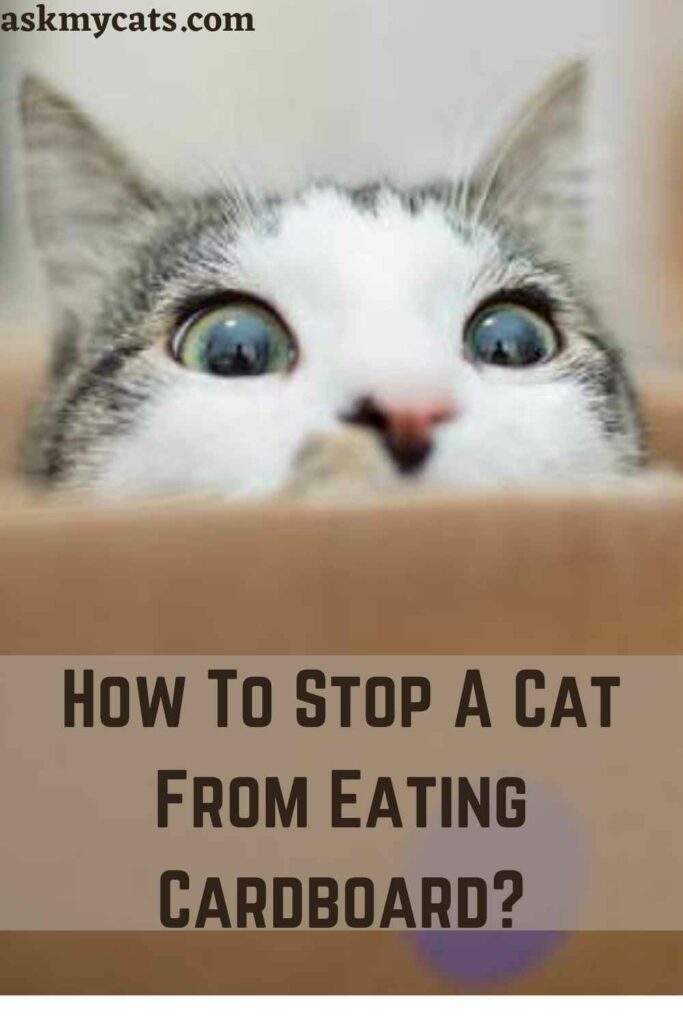Seeing your cat eat cardboard boxes, including paperback books, paper towels, diaper boxes, and so on, may appear strange to these obligate carnivores. It happens, believe it or not.
Pica is the chewing or eating of non-food items or things that have no nutritional value, such as litter, dirt, sucking wool, socks, shoelaces, plastic, plants, and so on.
So, why do cats eat cardboard?
A cat may eat cardboard due to a variety of reasons that range from teething to nutritional deficiencies to disease and conditions among many others.
Keep reading the article to know about all the reasons behind your cat eating cardboard and how you can stop it.


Give Your Cat the Perfect Day
Get the Free Ebook!
Cat Chewing Cardboard
One of the main reasons behind your cat chewing cardboard could be because of sore gums.
Some cats like to chew, while others don’t. Cats who enjoy chewing will likely draw toward cardboard boxes. They can be found in a variety of places, ranging from cereal boxes to moving boxes to the items you just received from your internet shopping binge.
Maybe you’ve been wondering if it’s something to be concerned about, or if it’s just your cat acting strangely. While many cats appear to like nibbling on cardboard boxes, it’s crucial to double-check the causes behind this habit.
If your kitten seems to like chewing on cardboard, she may be experiencing teething pain. Kittens get relief by chewing on cardboard boxes, just like human newborns get respite from biting down on teething rings.
If your adult cat is nibbling, it could mean she has a problem with her teeth or gums, such as gum disease. Gastrointestinal issues might also arise, and your cat, like a teething kitten, will chew to alleviate the agony.
If your cat’s gums are red, it could mean she has a problem with her teeth or gums, and she should see your veterinarian.
You might also buy some cat toys that are made to be chewed on and give her dental treats.
What Does It Mean When Cats Chew Cardboard?
Cats chewing on cardboard could mean a lot of things, some of them are: –

1. Territorial Reason
Your cat might be rubbing on the boxes in the same way she rubs on everything in sight (even your legs) to claim her territory.
Chewing on household things is a terrific method for a cat to leave her fragrance all over the place.
If your cat appears to be rubbing her face on the box in between gnawing sessions, it’s likely that she’s claiming these boxes as her own.
This isn’t a problem as long as she doesn’t get aggressive in guarding her domain.
2. Wanting To Hunt
Cats are excellent hunters, and they enjoy playing with their natural instincts.
All of us have witnessed our cats stalking, pouncing, and biting numerous toys (and sometimes our feet). The cardboard box could be another source of entertainment for your cat.
Because most cats, especially indoor cats, do not have the opportunity to hunt and kill prey, they will seek satisfaction from items.
If your cat bites the cardboard and uses bunny kicks (holding the box with their front legs while kicking it with their hind legs), she’s probably treating it like prey.
3. Constructing A Stronghold
Many aspects of cat behavior are influenced by their natural hunting instincts. Inside the enormous cardboard box, chasing the feather wand, rabbit kicking the large stuffie, and playing mad.
They like to jump out and whack your ankles as you go by, and there’s nothing better for a cat than a dark and enclosed location.
A cat’s attempt to make the box perfect for her requirements is sometimes part of this behavior. Perhaps she’ll chew a hole in the side of the box so she can peep out and stick her front leg out to get something.
4. Boredom
If your cat gets bored easily, chewing on cardboard boxes could be a fun way for her to pass the time and burn off some energy.
She could even be attempting to attract your attention. Cats, like a toddler that acts out to attract a parent’s attention, can occasionally act mischievously to get your attention.
If you pay attention to your cat while she’s doing something bad, you’re essentially teaching her that if she keeps doing it, she’ll always get your attention. So, when your bored feline acts this way, try your best to ignore them.
Cats are naturally curious and active animals who are endlessly entertained by a wide range of products and objects found in our daily lives.
They like to knock stuff off bookcases, sit on our laptops, lick our hair, and observe us brushing our teeth.
A cardboard box’s attractiveness stems from the fact that it’s a terrific location to explore, hide, sleep, and play.
The texture of the box may be appealing to gnaw on, and your cat may be releasing some of her wacky energy by playing hide and seek inside the box.
Why Do Cats Chew Cardboard?
The reason behind cats chewing cardboard could be because of a medical condition, known as pica, or it’s simply just who they are.

1. Medical Aspect
If your cat is consuming inedible materials like cardboard, he or she could be suffering from a medical condition known as cat pica.
Pica is the desire to consume inedible items.
Fabrics, elastics such as hair binders, cardboard, paper, and plastic are the most common objects found in cats.
Pica syndrome is more common in kittens and young cats.
Pica has no established etiology, but experts believe it could be caused by a variety of factors, including being weaned too soon, dietary inadequacies, heredity, boredom, compulsive behavior, or stress.
Pica can appear as early as 3 months of age, and some cats can grow out of it by the age of 1-2 years.
Pica sufferers may grind the object repeatedly along with their back molar teeth before swallowing, but many young cats will chew or rip apart items during play.
Susceptible people find this conduct extremely satisfying, and they will go to considerable lengths to find it. Pica is said to be more common in Oriental breeds due to their inclination to wool sucking activity.
When a cat just sucks on bedding, it is known as wool sucking. However, this activity can quickly become addictive and lead to the cat actually consuming the materials.
Some reasons for cat pica to occur include the following:
- Deficiencies
If your cat isn’t just chewing on cardboard but actually consuming it, it’s possible that your cat’s diet is lacking in certain nutrients. To make up for the difference, your cat eats foods that aren’t in its diet.
- Illness
If your cat is continuously eating cardboard, it’s possible that he or she has feline leukemia or is infected with a virus. The best thing to do in this scenario is to take your pet to the veterinarian for a check-up.
- Mental/Emotional Disorder
Your cat may be suffering from cat pica as a result of trauma or even species genetics, which is linked to your cat’s history. Some breeds are more affected than others.
2. Personality Trait
Cats are naturally lively creatures. They can only represent their emotions by chewing the cardboard because they are unable to convey them verbally.
Your cat could simply be bored or in a playful mood.
Perhaps they’re just anxious or irritated, and biting through cardboard is their way of expressing it while also expelling the excess energy.
Is It Safe For Cats To Eat Cardboard?
No, it is not safe for cats to eat cardboard as large chunks of cardboard wreak havoc on your cat’s digestive system.
Check to see whether your cat is chewing any cardboard. Large bits of cardboard could not only wreak havoc on your cat’s digestive system, but it could also be an indication of feline pica, a condition in which your cat feels compelled to eat non-food items.
So keep an eye on your cat, especially if it’s the first time they’ve played with cardboard.
Chewing on cardboard is usually perfectly harmless for your cat. To be safe, ensure sure your cat is simply chewing (not eating), and that any sharp edges or hazardous substances are avoided.
It could also be behavioral issues caused by obsessive disorders, boredom, early weaning, or stress. If your cat appears to be easily stressed, she may be destroying boxes out of nervousness, especially if she is also eating them.
Take your cat to the vet if you feel she’s been eating cardboard (or anything else that isn’t food) and has pica.
How To Stop A Cat From Eating Cardboard?
You can stop a cat from eating cardboard by: –

1. Removing It
The most straightforward way is to simply remove the box. It should be recycled or stored in a room, cellar, or closet where your cat will not be able to access it.
2. Redirect
When you notice your cat indulging in this behavior, you can divert her.
Remember the toddler rule. If you scold your cat, she will see it as a form of attention and will likely repeat the behavior.
It all starts with you attempting to figure out why your cat is chewing on the cardboard in the first place.
If your cat is bored, play with her more and make sure she has adequate toys and other activities to keep her occupied (access to look out of windows, etc.).
Finding a playmate for your cat, preferably another cat, can help her cease a number of undesirable behaviors and provide her with plenty of opportunities to play, making her less likely to become bored.
3. Discourage
Finally, there are techniques to keep your cat from gnawing on boxes. If your cat is chewing on boxes that need to stay put, there are sprays developed for animals that have a terrible taste and will keep your cat away from them.
Bitter apple spray, for example, maybe put on a surface to prevent your cat from acting out.
There are also sprays with motion detectors that can surprise your cat with a harmless loud hissing sound if you position them near the boxes. Aluminum foil or double-sided tape can be used as a deterrent on certain surfaces.
Frequently Asked Questions
Can Cats Digest Cardboard?
It’s not a good idea to eat cardboard or paper. They can be tough to digest, but if your cat just ate a small amount and it was a one-time occurrence, you shouldn’t be concerned. They should be able to digest the substance if they can chew and swallow it effectively in the first place.
Is It Normal For Cats To Chew Cardboard?
While some cats’ eating and licking may be linked to pica, chewing on cardboard is typically regarded as normal. Your cat may have a variety of reasons for munching on cardboard, but the most common explanation is that it’s entertaining.
How to make sure the carboard is safe for cats?
Avoid any sharp edges, that might be present on the cardboard. Cats might be a little too enthusiastic when it comes to chewing on cardboard. So much so that they may inadvertently injure themselves if they come into contact with a sharp edge. While the average Amazon box isn’t particularly sharp for your cat, there are some heavy-duty boxes that you shouldn’t share with him.
Final Words
While a cat chewing on cardboard boxes is considered a common and harmless habit, you should keep an eye on your cat when she is doing so. You want to make sure she doesn’t have any medical issues and isn’t injuring herself in any manner. Make sure the box is empty and hasn’t been treated with or contains any hazardous substances.
Allow your cat to have her fun as long as you know she is secure and you don’t mind small bits of cardboard scattered over your home.
If you have any unanswered questions, feel free to ask us in the comments sections.
